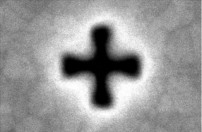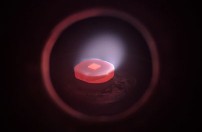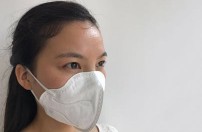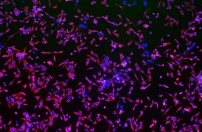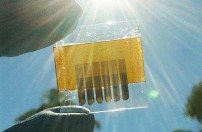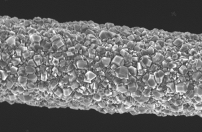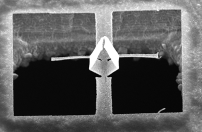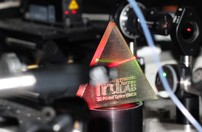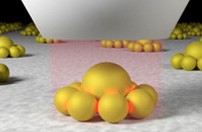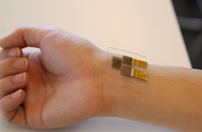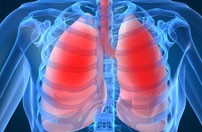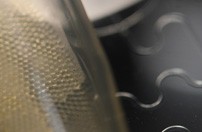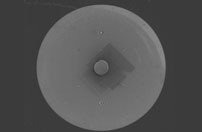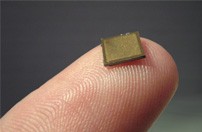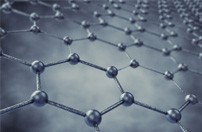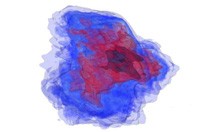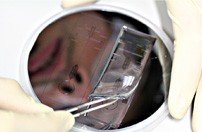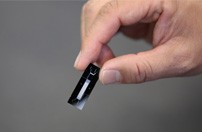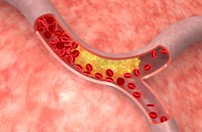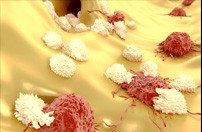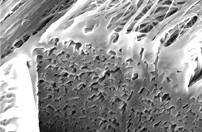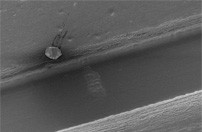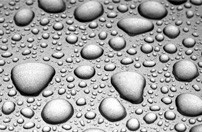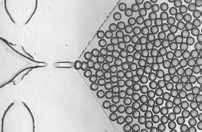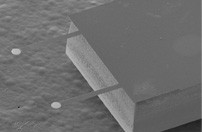All case studies
Current
Colour coded chemicals
The device uses the interaction between photons and electrons to filter out colours to create an ‘optical barcode’ that is specific to a sample and can be compared to a library of known material signatures.
Read more...Australia’s first superconducting diamond
In an Australian first, a Victorian team of researchers has created superconducting diamond.
Read more...Automatically assembling nanolenses
A team of researchers has created a scalable production method for a class of nanoscale lenses using the electrostatic forces between charged nanoparticles, enabling wider application of the technology.
Read more...Nanofibre facemasks provide a breath of fresh air
Deakin University’s Institute of Frontier Materials (IFM) has been ANFF VIC equipment to develop a new type of nanofibre facemask.
Read more...Ultrathin holograms open doors to 3D displays
A team from RMIT University and Beijing Institute of Technology have fabricated the world’s thinnest hologram – and it could revolutionise the way we interact with everyday technologies.
Read more...Providing a platform for muscle stem cell therapy
A team of Victoria-based researchers is taking tips from Mother Nature to make muscle stem cell (MSC) therapy a more effective and affordable option for treating degenerative diseases.
Read more...Creating back-contacted solar cells
By combining the benefits of back-contacted solar cells with perovskite materials, researchers have achieved a much sought after pathway to more efficient photovoltaic devices.
Read more...Diamond coating Carbon Fibre
A team of Victorian scientists have coated carbon fibre with diamond, enhancing the material’s usability in medical and sensor applications where the composite material offers huge potential advantages.
Read more...Exploring gold nanowires and nanorods
Professor Wenlong Cheng from Monash University has been exploring unique properties of gold nanomaterials for over 16 years. Two recent projects, conducted at ANFF-Vic’s Melbourne Centre for Nanofabrication (MCN), involved gold nanorods and gold nanowires.
Read more...Folding plasmene nanosheets
Professor Wenlong Cheng has been investigating how to make an unusual class of materials with exotic properties and unprecedented real-world applications.
Read more...High performance microfluidics increase solar panel efficiency
There is now a global drive towards making solar energy more affordable. However current technologies have defects – for every 10°C increase in operating temperature, most solar cells become around 5% less efficient. This project aims to tackle these problems.
Read more...Better batteries possible with alternative electrodes
The lithium-ion batteries currently used in every-day devices such as phones and laptops have limited charge hold and an operation time which decreases over the life of the battery. This project looks at alternative electrode materials to achieve longer lasting, more durable batteries.
Read more...Rapid prototyping to understand particle diffusion
The 3D printer at MCN is being utilised for the fabrication of specially designed optical prisms which are used to control light in order to understand the diffusion of particles during advanced self-assembly and transport processes.
Read more...Next generation pathogen detection with lab-on-a-chip platforms
Detection of pathogens is critical for disease diagnosis, food safety control, water quality monitoring and homeland security. Traditional detection methods are time consuming and complex – a portable lab on a chip enables fast and simple pathogen detection.
Read more...Twisting light for faster internet
With the advent of fibre optic networks the bandwidth of the internet increased dramatically. To decrease bottlenecks in next-generation internet speeds, current electronic switches are being replaced with optical equivalents.
Read more...Artificial leaves enhance light-to-chemical energy conversion
The chemical industry relies heavily on fossil fuel derived energy for carrying out chemical processes. A more sustainable and desirable prospect is to harvest sunlight for doing chemistry and transform this industry into a solar chemical manufacturing industry.
Read more...Nano-flowers for biosensing
Gold nanostructures separated by a small gaps show a strong focusing effect of the electric field into this gap when exposed to light. Using surface enhanced raman spectroscopy, these structures have the potential to detect minute quantities of molecules used in explosives or cancer markers in blood.
Read more...ALD could help prolongue battery life and improve reliability
Improving the charge and life-span of batteries in phones, laptops and household technologies has the potential to improve not only efficiency and flexibility of these technologies, but also minimise the amount of toxic landfill created as a result of disused batteries.
Read more...Fighting resistance to antibiotics
As resistance to antibiotics is becoming increasingly common, it has become even more important to understand the mechanism by which they work on bacterial cells and to develop new antibiotics which can be used agaisnt ’super bugs.’
Read more...Electronic skins – the future for medical devices
Technologies are increasingly becoming smaller, lighter and smarter, and now they are flexible and wearable too. Current rigid circuit board technologies are limited in their applications, particularly in regards to medical devices and bionics. Here, we look at wearable heart rate and blood pressure sensors.
Read more...Nanoscale optical circuits for light-speed information processing
The speed of the internet is largely reliant upon optical fibres which carry information, and the electronic devices used to encrypt and decrypt. This project looks at creating optical circuits smaller than the wavelength of light, to provide extremely high processing speeds.
Read more...Metal nanoparticles lead the way towards solar water decontamination
It has long been known that solar energy can be used to create electricity for heating and lighting. However, it can be also used to drive important chemical transformations such as the creation of low-cost water purification for developing countries.
Read more...Small fibres solving big problems
This project aims to solve the problems associated with producing nano fibres on a large scale so that they might be used in products such as face masks and respirators for highly polluted environments.
Read more...Micro sensors to monitor blood pressure
Hypertension, if left untreated, can lead to a number of health problems including strokes, heart failure and kidney failure. Current monitoring methods are inefficient and are not performed as regularly as necessary to monitor and mitigate these serious health concerns – cue micro sensors.
Read more...Microflow batteries the future for electric cars
As electric cars become more prevalent on our roads, research is continually undertaken to make their technologies, smaller, faster and more efficient. Eden BDM has taken residency at MCN to accomplish a microflow battery to enable the recovered energy of the moving car to recharge the battery.
Read more...Harvesting sunlight to fuel the modern world
Clean energies are vital for the future prosperity of our planet and harvesting energy from light sources, including sunlight, could provide a significant percentage of the world’s energy demands over the coming century.
Read more...Cancer treatment to be delivered to lungs
In treating diseases such as lung cancer, tuberculosis, cystic fybrosis and asthma, a large range of intravenous drugs are directed at the lungs but inefficiently delivered. A device is under investigation for the generation and delivery of aerosolised drugs directly to the lungs.
Read more...Microchips to mimic living cells
Researchers from CSIRO have successfully developed a microchip that mimics a living cell by housing millions of tiny water droplets which synthesise enzyme molecules. This is a critical step towards fast-tracking low cost protein development.
Read more...NASA connects to MCN for carbon nanotube growth
The NASA team has worked for several years to make their formulation of carbon nanotues black over a wide spectral range, and improve the robustness and the number of materials to which the nanotubes can be applied.
Read more...Black silicon sensors for molecular contamination
Black silicon provides a unique platform for a non-reflecting, all-direction-absorbing surface, which can be used for sensing and fingerprinting of molecular and microbial contamination. This is done by sensing the light scattered in air, water, food, body fluids by various compounds.
Read more...Ultra-thin optical sensors for the detection of toxic chemicals
Current chemical sensors pose a variety of inhibitors to their use such as cost, portability and reproduceability. Development of a new, ultra-thin, 2D optical material enables the rapid, sensitive and inexpensive detection of toxic chemicals in air, water and soil.
Read more...Archive
High resolution x-ray imaging possible for delicate biological samples
High-resolution x-ray imaging is required to investigate processes in delicate biological samples. Fresnel zone plates help to focus x-rays with high efficiencies, allowing for nanometer size beams to deeply penetrate the imaging subjects.
Read more...A pain-free solution to vaccines
Vaccinations, though vital in preventing the spread of disease in the modern world, have several major drawbacks which limit their effectiveness and uptake in developing countries. Professor Mark Kendall has spent the last ten years developing a needle free solution to immunisation.
Read more...Thinner, faster electronics and data transfer devices
Research into two dimensional, atomically thin materials such as Graphene, is opening the doors for a new generation of electronics that are thinner, faster and more robust than ever before.
Read more...Cells imaged without damage
Imaging cells is a vital part of understanding the biological processes of living organisms. Researchers from La Trobe Unversity have developed a new microscopy technique to x-ray cells at a nanometre scale with lower doses of radiation than previously possible.
Read more...Nanoscale antennas the future of telecommunications
Researchers from the University of Melbourne and CSIRO have developed nanometer sized optical antenna based on every-day radio frequency designs. The novel designs are focused enhancing radiation from a single photon emitter.
Read more...Self-assembling gold nanorods show huge potential
Nanostructures fabricated with metal nanoparticles hold great promise for applications in biosensing, optical analysis, computing and solar energy conversion. One approach looks at programming the spontaneous self-assembly of nanoparticles into the desired architecture.
Read more...Detecting chirality of biological molecules
Many biological molecules are chiral, meaning that they come in left-handed and right-handed forms even though they are chemically identical. Detecting these forms is important as their handedness affects their interactions.
Read more...Safeguarding water against oil spills and polution
Oil spillage, organic solvents and other industry contaminants are primary pollutants of water sources around the globe. The existing conventional methods used to solve spillages are not very efficient and have their own environmental consequences. New nanomaterials and nanotechnology are aiding the development of new high-efficient absorption materials.
Read more...Nano-engineered intelligent delivery systems
Multidrug resistance is a growing problem as methods of treatment that have been relied upon in the past are no longer effective. Together with MCN, researchers from Monash University are looking to develop an intelligent drug delivery system that combats multidrug resistance.
Read more...Protecting the nations’ water supply
Microfluidic sensing platforms capable of sorting and filtering nano-particles within aquatic sensor systems may hold the key for future pathogen detection within community water supplies.
Read more...Safer surgeries with microbots
Microrobots are making minimally invasive, vascular surgery even less invasive and risky. Researchers at MCN have developed a 240 micron diameter micromotor capable of navigating through arteries deep inside the human body.
Read more...Industry R&D looks at water source analysis
Through the Small Technologies Industry Uptake Program (STIUP), MCN has assisted a Melbourne based water management company to develop an automated water sensor production process to commercialise pollutant analysis sensors.
Read more...Automated systems for cell transfection
Incorporating nanosystems into experiments can provide useful insight into the interaction of nanomaterials within the biological environment, gene expression, targeted cell delivery and encapsulation.
Read more...Synthesising high quality enzymes
In nature, enzymes are used to catalyse and break down proteins. New methods of synthetic production have vastly broadened the applications of such enzymes.
Read more...Identifying key materials for chemical sensors
Researchers from CSIRO have been working with MCN to develop a rapid, convenient and effective solution for discovering multicompositional materials useful in the development of chemical sensors.
Read more...50nm biosensors to detect antigens
Through using EBL to develop a set of processes to fabricate biological nanosensors, researchers at MCN and the University of Melbourne have developed a nanosensor that is sensitive to a specific type of biological antigen.
Read more...Predicting artery plaque rupture
Due to lipid build up in artery walls, plaques form that can rupture and cause significant health problems for patients. Researchers at the Baker institute have worked together with MCN to study and predict the likelihood of plaque rupture in an attempt to prevent it.
Read more...Liquitab, not a hard pill to swallow
The days of costly liquid antibiotics will soon be over for people who have difficulty swallowing pills. Liquitab has engaged with MCN to develop a unique technology, capable of grinding pills into a palatable liquid.
Read more...Enhancing Victorian mussel farms’ profitability
Utilising the Objet 3D printer for rapid prototyping, researchers at MCN have designed a 3D polymer structure to improve mussel spat capture and enhance the settlement of larvae to ultimately improve the profitability of Victorian mussel farms.
Read more...Nanoscale study of biological cells
Focused Ion Beam Scanning Electron Microscopes are enabling the study of biological cells on a nanoscale as researchers at MCN and Monash University are utilising the FIB-SEM as well as protein nanoprobes to study protein assemblies and their place within cells.
Read more...Creating corrosion-proof materials
Corrosion is an every-day problem that shortens the life of machinery, buildings, cars and infrastructure. CSIRO have engaged with MCN to develop oxide coated materials to prevent corrosion and ultimately, rust proof the future’s metals.
Read more...Rapid point of care sensor for infectious disease discrimination
Together with Biodetectors Pty Ltd, MCN is working on the rapid point of care sensor for infectious disease discrimination. This technology is useful in the fields of genetic screening, diagnostics, drug delivery and protein analysis.
Read more...Cantilever-based biosensors to help detect cancer antibodies
Utilising a photoactive material, researchers at MCN and Deakin University are designing a cantilever-based biosensor which detects cancer biomarker antibodies.
Read more...Carbon nanotubes set to become stronger
Carbon nanotubes are known for their strength and rigidity which is about 1000 times the strength of steel. However the breaking strength of spun CNTs is generally less than 1% of their theoretical value. MCN is collaborating with CSIRO to increase their potential.
Read more...SEM images of CNT webs
Scanning Electron Microscope images of Carbon NanoTube webs were deposited on a thermoplastic polymer and hot-embossed to form microfluidic channels, in order to establish whether the CNT webs layer would conform to the embossed structure without losing the film continuity and the alignment.
Read more...SEM images of high accuracy nanostructures
In this project a set of processes were developed to fabricate nano-scale metal structures in order to study their interaction with visible light. The ultimate goal is to incorporate these structures into all-optical signal-processing devices.
Read more...Acoustic nanofluidics
Simulated molecular dynamics at the nanoscale show tremendous potential for improved manipulation of particles and molucules in fluids. This project examines rapid fluid flow in nanochannels induced by surface acoustic waves.
Read more...Understanding emulsions and foams
Researchers from the University of Melbourne are fabricating nano- and micro-sized devices to integrate with atomic force microscopy to develop new tools to study the collisions between bubbles and drops in emulsions and foams.
Read more...Enhancing sensing applications
In sensing applications, it is necessary to create strong light field enhancement on a nanoscale. The challenge is to increase the light field enhancement, which is limited by the “sharpness” of the edges and corners of nanoparticles and is linked to fabrication resolution.
Read more...Detecting chemicals and biological contaminants
As different chemicals interact with light in different ways, researchers from CSIRO are developing new ways of detecting chemicals and biological contaminants, using light to detect and identify the different chemicals and biological substances.
Read more...Improving cancer therapies
The ability to efficiently deliver large therapeutic molecules into cancer cells, without harming healthy cells remains a largely unsolved technological challenge. Researchers from Monash University are addressing this by developing nanoscale therapeutic carriers, with improved efficacy and specificity.
Read more...Environmental monitoring with nanobio membranes
Researchers from Monash University are developing intelligent, ultra-thin nano-biomembranes for applications in environmental monitoring. This work will lead to improved technologies in sea water desalination, for example.
Read more...Bottom up methods for nano building blocks
A lack of suitable bottom-up fabrication methods which allow for the assembly of custom-defined nanostructures impedes the integration of a plethora of new nanoparticulate building blocks into everyday devices in applications such as electronics, optoelectronics, sensing and photovoltaics.
Read more...Evolving enzymes on a microchip
This project aims to develop an integrated microfluidic chip that can perform in vitro enzyme synthesis and evolution, potentially revolutionising nano- and bio-technologies.
Read more...Vertical arrays of gold nanorods achieved
Fabrication of novel self-assembling metallic nanostructures shows great potential for applications in biosensing, optical analysis, computing and solar energy conversion.
Read more...Cantilevers to assist with fluid characterisation
This project looks at the development of silicon cantilevers with different spring constants and gold paddle sizes to assist with characterisation of deformable drops on Confocal and AFM systems.
Read more...Manipulating hot spots to increase biosensor sensitivity
Through the characterisation of gold nanoparticle surface assemblies and the manipulation of their electric field hot spots, researchers at MCN and Monash University are looking to increase the sensitivity of biosensors.
Read more...Photonic circuitry from the noble metals
Researchers from MCN and Monash University are collaborating to fabricate linear arrays of nanocrystals using the Focused Ion Beam-Scanning Electron Microscope.
Read more...
